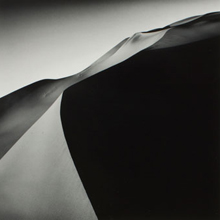Surface: Landscape Photography from the Collection

Simon Norfolk (British, born Nigeria, born 1963), Untitled (Namibia), 1998, gelatin silver print, Museum Purchase: Jessie Jonas Charitable Fund, © 1998 Simon Norfolk, 1999.78.48
2013
Long a favorite of painters and printmakers, the untrammeled landscape has been a significant subject for photographers since the early years of the medium. The pictures of waterways, forests, deserts, mountains, and striking natural phenomena on view in this installation survey 150 years of the photographic landscape tradition. Surface evokes a world seemingly untouched by humankind through images that reflect established artistic and spiritual philosophies that celebrate the relationship of the individual to the natural world.
Scientific developments in photography took place in Europe during the first half of the nineteenth century, just as the Romantic movement in art and literature was promoting nature as a refuge from the increasing industrialization of modern society. While camera technology, which became widely available in the 1840s, could and did document the physical world, prevailing artistic trends led many photographers to instead create atmospheric, poetic imagery. Their landscape photographs sought to embody the ideals of Romanticism, suggesting nostalgia for an untamed wilderness that soothed the spirit.
Transcendentalism, a philosophical approach that gained prominence in the United States during the 1830s and 1840s, also encouraged the consideration of the landscape. The physical and spiritual connections between man and nature as evidenced by the visible cycles of growth, decay, death, and regeneration became important aesthetic subjects. During the later nineteenth century, as the borders of the United States expanded westward, photographers emphasized the raw beauty, scale, and sublimity of the vast new terrain.
Though mankind’s influence on the natural world has at times supplanted the pure landscape, echoes of Romantic and Transcendental traditions remain important sources of inspiration for photographers. Ansel Adams’ twentieth-century views of the West inspired a generation of photographers to produce detailed compositions, while Minor White evoked intimate thoughts and feelings through abstracted and poetic natural forms. Today, photographers including Stephen Vaughan and Karen Glaser carry on the landscape tradition, seeking out pristine spaces that embody Transcendental theorist and poet Ralph Waldo Emerson’s assertion that the beauty of nature is essential to humankind: “The health of the eye seems to demand a horizon. We are never tired, so long as we can see far enough.”
Curated by Julia Dolan
- Exhibition Title
Surface: Landscape Photography from the Collection
- Date
2013
- Curated by
Julia Dolan
- Begin Date
2013-01-11
- End Date
2013-04-28






